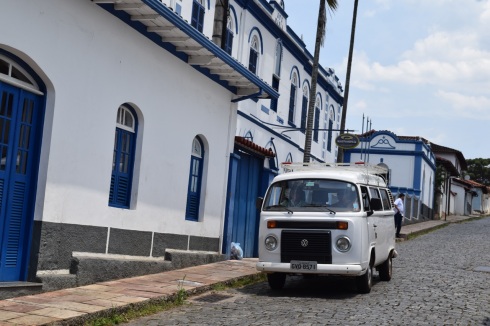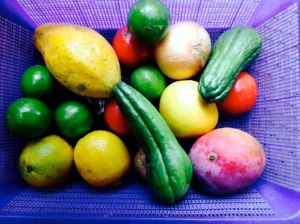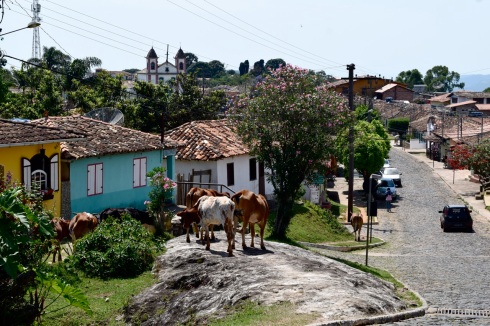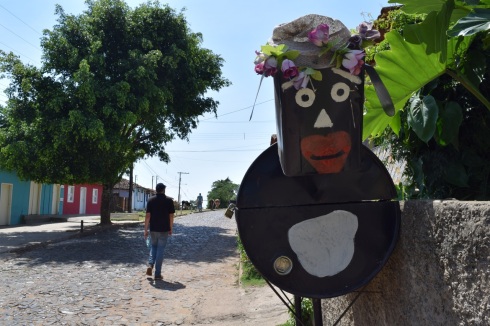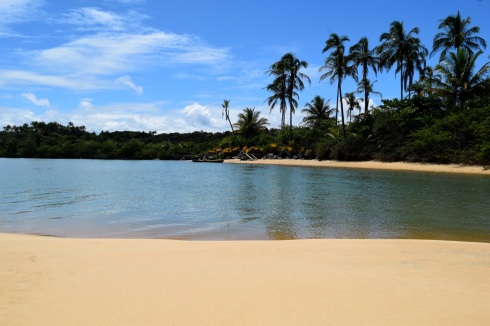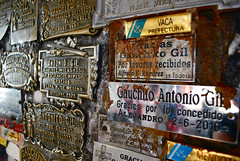Tandil, Buenos Aires province, Argentina
[by Paula]
As we arrived in Brazil we were entering the last new country of the trip. By now we were surely hardened, weathered old pros, weren’t we?
But in many ways our first experiences there reminded us of the beginning of our journey in Mexico, starting with us completely cocking up the border crossing and managing to drive straight into the country without so much as a cursory wave to the immigration service. We drove round the back streets of Uruguaiana, dazed, confused and wondering how it’s even possible to slip through a frontier – driving a fat white gringo-mobile – without being stopped by a single passport inspector.
Unlike our embarrassing rebound into the USA on day one of our trip, we at least managed to find the office before accidentally returning to Argentina.
While there have been loads of little differences between each of the countries we’ve visited, overall we’ve become comfortably accustomed to the more commonly-held customs and practices in Latin America – greetings and interactions, food, street signs, where to shop for things, driving behaviour, or the way towns are almost uniformly laid out and streets similarly labelled with the names of places, dates, military generals or revolutionary heroes.
But Brazil had always felt to us like it would be a different world, mainly because… well, I’m not entirely sure why. The most obvious and immediate difference is that the language of Brazil is Portuguese, not Spanish, and we don’t speak it. While many of the words are similar, the pronunciation can be really tricky for the untrained ear.
When we eventually found the immigration office, the woman at the desk rattled off a very very long nasal-sounding word that was presumably an entire sentence of separate words. We just stared at her. Yep, it was all coming back – we distinctly remembered this sensation of feeling clueless, a little awkward and completely on the back foot.
We stocked up on food, water and cash and set off for what was to be a long journey, albeit with some interesting stops along the way. Driving 3,500km in 8 days is not really our style, but we had a relatively limited time in Brazil and decided to hot-foot it to our most northerly point then give ourselves more time to work our way south down the coast.
Our first night was spent camping on the street outside the Jesuit mission at São Miguel das Missões, as we couldn’t find anywhere suitable to stay and were still too newbie to ask around properly. Next morning a guy called out from his car as he drove past, giving us the thumbs up and pointing at the pop-top. We went to visit the mission and it turned out he worked there. He said loads of friendly-sounding words to us, and we sort of understood about 1 in 10 of them. That Brazilians were typically very warm and chatty was a stereotype we were fully expecting to be true.
We wandered round the lovely site under a warm, clammy sky. We hadn’t set out to do such a thorough study of the 17th and 18th century Jesuit social experiment but we’d now visited missions in all the main South American countries they’d settled in – Bolivia, Paraguay, Argentina and Brazil – and were feeling quite well versed by the time we took off across country.
We’d already noticed the volume of traffic – especially trucks – was huge compared with Argentina, which can feel like it’s practically empty in parts. Not since Colombia had we really had to contend with such aggressive, erratic driving. It was just another new thing to get used to.
Even the horse-drawn carriage drivers did some damned stupid manoeuvres..
On day two we had an early lesson in surviving Brazilian truckers while driving a winding, hilly route through Rio Grande do Sul province. On lengthy up-hill stretches the road would turn into three lanes so slower-moving traffic could yield to faster vehicles. We’re not super quick so as we approached an incline, I moved immediately into the right-hand slow lane.
As we started to climb an articulated lorry loomed up behind at incredible speed, leaning on his horn while over-taking us. We had no idea what his problem was. As his cab passed us he started pulling sharply to the right, cutting us up completely and forcing us off the road. I couldn’t believe what was happening – I was shouting something like “fucking hell, he’s coming in, he’s coming in!” as he came closer and closer and I stepped on the brakes. The double-length truck was so massive it never seemed to end. As it bore down on us there was no way we could avoid him so I had no option but to swerve into the ditch. Thankfully the drop-off was only the height of a normal kerb and we were still upright and unscathed, albeit with pretty shaky legs.
For most of the next hour this homicidal maniac tried to chase us down.
The first thing we said to each other was that it had obviously been deliberate, but we couldn’t imagine why. He had about a kilometre of overtaking lane ahead of him, so there was no need to pull in front of us. We wondered if he had an issue with our US licence plates? This has never happened before though, at least not to our knowledge. I just wanted to get the hell away from him – now that he had overtaken, his heavy truck was crawling up the hill at a snail’s pace. I went to overtake and he swerved out in front of us. He did it again on the second attempt. Wtf?! By the time I finally got my opportunity we were pretty pissed off – as I overtook Jeremy gave that bastard a good long look at his middle finger and I leaned on the horn.
That was, possibly, not the cleverest idea. For most of the next hour this homicidal maniac tried to chase us down, accelerating up behind us when he got the chance and managing to intimidate the hell out of us. We wrote down his number plate just in case, and I drove like the clappers until we could create a gap then pull in to a gas station to wait for a while and let him get far ahead.
It’s fair to say we were suddenly feeling a bit unwelcome! Were all truckers this unhinged? What about everyone else?!
We planned on sleeping at gas station truck stops most of the way across the country until we got to the beach. Hmmm. That night we arrived at the first one, and had a quick look around to make sure our ‘friend’ wasn’t there. Maniacs or not, the first couple of days in a new culture are always a bit weird, while you work out what’s what.
We were settling in, feeling a little edgy, when a truck driver came over to chat and ask us about the van. We threw in a couple of Portuguese words but otherwise stuck to Spanish in the hope we’d be understood, and had something resembling a conversation. He was really nice – a really nice truck driver! A few minutes later he came back over and offered us a piece of Brazilian cheese to try. A really nice cheese-giving truck driver – even better!
For the next few days we drove through mile upon mile of agriculture – endless fields of soy, maize and wheat – as well as a stream of towns and cities. We were genuinely amazed at just how densely populated it was. It wasn’t the most relaxing driving experience. Lorries would sit so closely on our tail we could almost smell their sweaty crotches. But at least none of them seemed to be actively trying to kill us.
Our faith was further restored by the reception we were getting from other car drivers. A remarkable number of people were hooting, waving and pointing at our gringo van, giving us the thumbs up. More alarmingly, lots of people were risking crashing by taking photos of us whilst driving along the highway. One guy overtook us then held his iPhone out of the driver’s window to take a picture of the front of our van. I’m pretty sure competence-in-backwards-photography-while-driving-at-high-speed is not in the standard driving test.
The weather got progressively hotter, more humid and occasionally stormy. Within a few days we were remembering what it was like to spend a day driving in the van, being slowly boiled alive, but we were relishing the warmth. We drove all day and sweated through the nights at petrol stations.
It’s amazing how quickly one becomes institutionalised. Wake up, drive, eat crackers, drive, stop, make pasta, sleep, repeat. After the fifth day of this we had a ‘big night out’ with some ice-cold beers and our first taste of Brazilian food. Whoop! The night out was about 6ft from the van, in a petrol station bar, but we are very easily excited.
Everything was so lush and tropical. We bought juicy mangoes and pineapples again, okra, cheap bananas and so many limes. How we’d missed proper limes! The insects were of the tropical variety too, like the dragonfly trapped in the bonnet that was so big Jeremy had to use BBQ tongs to remove it. As I stuck my head out the window one day to look down the street, a massive cicada flew straight at me and hit me right between the eyes, actually breaking the skin. I’m not sure which of us was more shocked.
We were starting to get a feel for the place, although sometimes it’s just silly little things make you feel in or out of synch.
After about a year in Argentina we more institutionalised in their ways than we have been anywhere. For example, instead of ringing a doorbell or shouting out, it’s normal to clap your hands when calling at someone’s house or business. Do they do that in Brazil, we wondered? In some countries it would certainly be interpreted as rude. Who could we ask? Maybe we could try clapping and see if someone punches us in the face….
On the other hand, one Argentinian custom we had never quite got used to was the interminable daily siesta where – outside of the big cities – pretty much everything shuts down for up to 4 hours in the middle of the day. We were immediately struck by the constant activity in Brazil – everything open, music, people out and about, working, snacking, drinking coffee or cold beer, all day long! Brilliant.
We were also tickled to hear a new form of greeting that’s common in parts of Brazil. A way of saying ‘hi’ is ‘oi!’. When we said ‘ola’ to people, they’d respond with ‘oi!’, or we’d walk into a cafe and the waitress would shout ‘oi!’. We literally never tired of it.
We arrived in the state of Minas Gerais, famous for the beautiful baroque architecture of its colonial towns – enriched during the 17-18th century gold rush – and its special cuisine. I’ve babbled so much already there’s hardly space to write about it.
We were relieved to find a haven of a campground in Tiradentes, where we could clean up and rest for a few nights, wander its lovely streets and sample some new foods like feijão tropeiro – a hearty spread of pork cooked several ways, beans with toasted manioc flour, couve (kale), sausage, eggs and rice.
We baked in the heat at Lavras Novas, a lovely old town still inhabited by the descendants of freed black slaves.
By the time we pulled into Mariana we were pretty desperate to find a launderette, something we knew could be a bit harder to find in Brazil. We pulled up to get our bearings, when a resident Italian called Flavio came alongside us to ask all about our trip and if we needed any help. I told him we needed to wash our clothes. “There’s nothing like that here, it’s really difficult,” he said.
Before we knew it we were following his little Fiat van (of course) through the winding cobbled streets, at great speed, to an unmarked place in the centre of town. It was a commercial laundry but he persuaded them to take our stuff, then drove us to a car park where he said we could safely spend the night. It would have been okay in different weather, but the heat was utterly phenomenal – we needed somewhere with shade, a shower and some peace and quiet.
We headed to nearby Ouro Preto to camp outside town and enjoy its incredible churches and colourful architecture, perched on steep cobbled streets. At the height of the gold boom there were more people in this small town (mostly slaves) than in New York and Rio de Janeiro combined.
Obviously most of the money was filched by the colonising Portuguese, but the town still retains a shiny feel. These days it’s all boutique B&Bs and chi-chi cafes. Here we finally sampled pão queijo, the region’s addictive and ubiquitous snack of cheesy bread, made with tapioca flour, which has a wonderfully soft chewy texture.
All very cultured, but it was time to turn towards the coast and spend some time lying down with a book. We had our eye on a quiet, relatively remote little town called Caraiva, in Bahia state, which had an amazing beach at the mouth of a river. The town itself could only be reached by canoe, but we were fairly confident we could find a base camp on the other side of the river.
The scenery along the way turned from rolling hills to striking mountains that seemed to have just popped straight up out of the earth. Even some of the petrol stations were beautiful!
Two sweaty days later we reached the turn off for the dirt road down to the village. A collapsed bridge turned it into a 2-hour journey through curvy bumpy tracks. We were knackered and parched when we arrived. We’d planned on going to a B&B that also offered camping, but when we got there it had closed its camping down and nothing else in town was open. Bugger! All previous shyness about communicating went out of the window, as I practically begged them to let us camp in their garden anyway. We were desperate for a nice little space where we could stay for a few days. The lovely family that owned it said they’d stopped the camping service because it wasn’t worth the trouble, but they eventually relented, charging us next to nothing to camp among their palm trees.
Luckily there was an Argentinian staying there who came along later to help translate. “Tell them we’ll be no trouble and we won’t make a mess!” I said.
We’d made it! It was as stunning as we’d hoped. One of the best beaches we’d ever seen. Now we could relax.
That night I woke up with a start at about 3am. “Something just bit my finger!” I said. We were both so sleepy though that we just ignored it. I’m always dangling my hand down the back of the bed – perhaps I’d snagged it on something on the back door?
Little did we know then that someone had other ideas about us chilling out, just going to the beach, catching some early nights and not giving our hosts any trouble. Señor Mouse had hopped on board for a visit, and he was definitely planning on outstaying his welcome.
Days: 1548
Miles: 47,158
Things we now know to be true: It’s not worth getting into an argument with a Brazilian truck driver.
A FEW MORE PICS BELOW! Click on any image to open the gallery:









